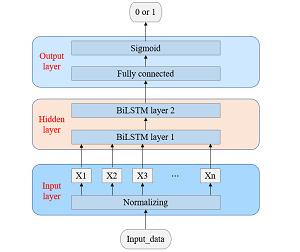Design of Deep Learning Acoustic Sonar Receiver with Temporal/ Spatial Underwater Channel Feature Extraction Capability
DOI:
https://doi.org/10.46604/ijeti.2023.13057Keywords:
underwater acoustic, deep learning, frequency-shift keying (FSK), feature extraction, virtual time reversal mirror (VTRM)Abstract
In this study, deep learning network technology is employed to solve the problem of rapid changes in underwater channels. The modulation techniques employed are frequency-shift keying (FSK) and the BELLHOP module of MATLAB; they are used to create water with multipath, Doppler shifts, and additive Gaussian white noise such that underwater acoustic receiving signals simulating the actual ocean environment can be obtained. The southwest coastal area of Taiwan is simulated in the manuscript. The results reveal that optimizing the environment by using the virtual time reversal mirror (VTRM) technique can generally mitigate the bit error rates (BERs) of the deep learning network’s model receiver and traditional demodulation receiver. Lastly, seven deep learning networks are deployed to demodulate the FSK signals, and these approaches are compared with traditional demodulation techniques to determine the deep learning network techniques that are most suitable for marine environments.
References
M. B. Porter, The BELLHOP Manual and User’s Guide: Preliminary Draft, Heat, Light, and Sound Research, Inc. Technical Report 260, January 31, 2011.
N. Morozs, W. Gorma, B. T. Henson, L. Shen, P. D. Mitchell, and Y. V. Zakharov, “Channel Modeling for Underwater Acoustic Network Simulation,” IEEE Access, vol. 8, pp. 136151-136175, 2020.
R. Jiang, S. Cao, C. Xue, and L. Tang, “Modeling and Analyzing of Underwater Acoustic Channels with Curvilinear Boundaries in Shallow Ocean,” IEEE International Conference on Signal Processing, Communications and Computing, pp. 1-6, October 2017.
O. Onasami, D. Adesina, and L. Qian, “Underwater Acoustic Communication Channel Modeling Using Deep Learning,” Proceedings of the 15th International Conference on Underwater Networks & Systems, pp. 1-8, November 2021.
Y. Li, B. Wang, G. Shao, S. Shao, and X. Pei, “Blind Detection of Underwater Acoustic Communication Signals Based on Deep Learning,” IEEE Access, vol. 8, pp. 204114-204131, 2020.
Y. Liu, F. Zhou, G. Qiao, Y. Zhao, G. Yang, X. Liu, et al., “Deep Learning-Based Cyclic Shift Keying Spread Spectrum Underwater Acoustic Communication,” Journal of Marine Science and Engineering, vol. 9, no. 11, article no. 1252, November 2021.
D. R. Jackson and D. R. Dowling, “Phase Conjugation in Underwater Acoustics,” The Journal of the Acoustical Society of America, vol. 89, no. 1, pp. 171-181, January 1991.
W. A. Kuperman, W. S. Hodgkiss, H. C. Song, T. Akal, C. Ferla, and D. R. Jackson, “Phase Conjugation in the Ocean: Experimental Demonstration of an Acoustic Time-Reversal Mirror,” The Journal of the Acoustical Society of America, vol. 103, no. 1, pp. 25-40, January 1998.
A. J. Silva and S. M. Jesus, “Underwater Communications Using Virtual Time Reversal in a Variable Geometry Channel,” OCEANS '02 MTS/IEEE, vol. 4, pp. 2416-2421, October 2002.
R. James, H. Appukuttan, and L. A. Joseph, “Mixed Noise Removal by Processing of Patches,” Proceedings of Engineering and Technology Innovation, vol. 17, pp. 32-41, January 2021.
M. Li, H. Zhong, and M. Li, “Neural Network Demodulator for Frequency Shift Keying,” 2008 International Conference on Computer Science and Software Engineering, vol. 4, pp. 843-846, December 2008.
I. Masmitja, D. Corregidor, J. M. López, E. Martinez, J. Navarro, and S. Gomariz, “Miniaturised Bidirectional Acoustic Tag to Enhance Marine Animal Tracking Studies,” IEEE International Instrumentation and Measurement Technology Conference (I2MTC), pp. 1-6, May 2021.
F. Qu, Z. Wang, L. Yang, and Z. Wu, “A Journey Toward Modeling and Resolving Doppler in Underwater Acoustic Communications,” IEEE Communications Magazine, vol. 54, no. 2, pp. 49-55, February 2016.
Z. Gong, C. Li, and F. Jiang, “Analysis of the Underwater Multi-Path Reflections on Doppler Shift Estimation,” IEEE Wireless Communications Letters, vol. 9, no. 10, pp. 1758-1762, October 2020.
A. Farina, “Simultaneous Measurement of Impulse Response and Distortion with a Swept-Sine Technique,” 108th AES Convention, article no. 5093, February 2000.
T. B. Santoso, E. Widjiati, Wirawan, and G. Hendrantoro, “The Evaluation of Probe Signals for Impulse Response Measurements in Shallow Water Environment,” IEEE Transactions on Instrumentation and Measurement, vol. 65, no. 6, pp. 1292-1299, June 2016.
L. D. Ding, S. L. Wang, and W. Zhang, “Modulation Classification of Underwater Acoustic Communication Signals Based on Deep Learning,” OCEANS-MTS/IEEE Kobe Techno-Oceans (OTO), pp. 1-4, May 2018.
D. Utebayeva, M. Alduraibi, L. Ilipbayeva, and Y. Temirgaliyev, “Stacked BiLSTM - CNN for Multiple Label UAV Sound Classification,” Fourth IEEE International Conference on Robotic Computing (IRC), pp. 470-474, November 2020.
R. Jiang, S. Cao, C. Xue, and L. Tang, “Modeling and Analyzing of Underwater Acoustic Channels with Curvilinear Boundaries in Shallow Ocean,” IEEE International Conference on Signal Processing, Communications and Computing, pp. 1-6, October 2017.
W. Y. Chen, “Simulation and Analysis of Sonar Performances: The Study on Estimation Around Taiwan Waters,” M.S. thesis, Institute of Undersea Technology, National Sun Yat-sen University, Kaohsiung, Taiwan, 2013.
F. B. Louza and S. M. Jesus, “The Effects of Upwelling over Low SNR Communications in Shallow Water,” OCEANS 2021 San Diego – Porto, pp. 1-6, September 2021.

Published
How to Cite
Issue
Section
License
Copyright (c) 2024 Chih-Ta Yen, Un-Hung Chen

This work is licensed under a Creative Commons Attribution-NonCommercial 4.0 International License.
Copyright Notice
Submission of a manuscript implies: that the work described has not been published before that it is not under consideration for publication elsewhere; that if and when the manuscript is accepted for publication. Authors can retain copyright in their articles with no restrictions. Also, author can post the final, peer-reviewed manuscript version (postprint) to any repository or website.

Since Jan. 01, 2019, IJETI will publish new articles with Creative Commons Attribution Non-Commercial License, under Creative Commons Attribution Non-Commercial 4.0 International (CC BY-NC 4.0) License.
The Creative Commons Attribution Non-Commercial (CC-BY-NC) License permits use, distribution and reproduction in any medium, provided the original work is properly cited and is not used for commercial purposes.







.jpg)


